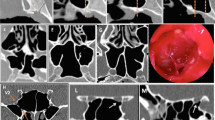Abstract
The objectives of this study are to evaluate the occurrence of postoperative middle turbinate lateralization and the relationship between this lateralization and the risk of iatrogenic sinusitis after endoscopic transnasal sphenoidotomy procedure. Patients who undergone endoscopic transnasal sphenoidotomy and came under the surveillance of our otorhinolaryngology department between the January of 2010 and the December of 2015 were retrospectively scanned. Among them, the patients who were evaluated with paranasal sinus computed tomography (CT) postoperatively were included in the study. The amount of middle turbinate lateralization in each patient was evaluated by comparing their routine preoperative CT image with the postoperative CT image. The air-fluid levels or soft tissue opacifications in the sinuses or obstruction of the ostiomeatal complex were accepted as the evidence of sinusitis on the images. The patients were asked questions regarding their symptoms of sinusitis on a phone interview for the statistical evaluation of their preoperative and postoperative Visual Analog Scale scores of complaints of sinusitis. The difference between preoperative and postoperative measurements was found to be statistically significant (p < 0.001, 95% CI). The middle turbinate position was lateralized in 31 patients (81.6%), medialized in four patients (10.5%), and remained unchanged in three patients (7.9%). Overall, the sinus opacification and mucosal thickening rates did not change significantly which suggested the operation did not pose patients at increased risk of sinusitis. Mean VAS scores of complaints of sinusitis did not change significantly except for sensation of facial pressure, which showed a minor but statistically significant decrease (p < 0.001). This study revealed the lateralization of the middle turbinate after transnasal sphenoidotomy. However, it seemed that this lateralization did not create a predisposing factor for the development of acute and chronic sinusitis.


Similar content being viewed by others

References
Carrau R, Jho H, Ko Y (1996) Transnasal–transsphenoidal endoscopic surgery of the pituitary gland. Laryngoscope 106(7):914–918
Castelnuovo P, Pagella F, Semino L, Bernardi F, Del G (2004) Endoscopic treatment of the isolated sphenoid sinus lesions. Eur Arch Otorhinolaryngol 262(2):142–147
Castelnuovo P, Pagella F, Semino L, Bernardi F, Del G (2000) Surgical causes of failure in endoscopic sinus surgery. Laryngoscope 110(1):177
Musy P, Kountakis S (2004) Anatomic findings in patients undergoing revision endoscopic sinus surgery. Am J Otolaryngol 25(6):418–422
Berlucchi M, Castelnuovo P, Vincenzi A, Morra B, Pasquini E (2008) Endoscopic outcomes of resorbable nasal packing after functional endoscopic sinus surgery: a multicenter prospective randomized controlled study. Eur Arch Otorhinolaryngol 266(6):839–845
Bolger W, Kuhn F, Kennedy D (1999) Middle turbinate stabilization after functional endoscopic sinus surgery: the controlled synechiae technique. Laryngoscope 109(11):1852–1853
Hewitt K, Orlandi R (2016) Suture medialization of the middle turbinates during endoscopic sinus surgery. Ear Nose Throat J (serial online). 2 December 2008. Academic Search Complete, Ipswich. Accessed 9 June 2016
Cappabianca P, Cavallo L, Colao A, de Divitiis E (2002) Surgical complications associated with the endoscopic endonasal transsphenoidal approach for pituitary adenomas. J Neurosurg. 97(2):293–298
Bassiouni A, Chen P, Naidoo Y, Wormald P (2014) Clinical significance of middle turbinate lateralization after endoscopic sinus surgery. Laryngoscope 125(1):36–41
Nyquist G, Anand V, Brown S, Singh A, Tabaee A, Schwartz T (2010) Middle turbinate preservation in endoscopic transsphenoidal surgery of the anterior skull base. Skull Base 20(05):343–347
Marchioni D, Alicandri-Ciufelli M, Mattioli F et al (2008) Middle turbinate preservation versus middle turbinate resection in endoscopic surgical treatment of nasal polyposis. Acta Otolaryngol 128(9):1019–1026
Choby G, Hobson C, Lee S, Wang E (2014) Clinical effects of middle turbinate resection after endoscopic sinus surgery: a systematic review. Am J Rhinol 28(6):502–507
Fortune Duncavage J (1998) Incidence of frontal sinusitis following partial middle turbinectomy. Ann Otol Rhinol Laryngol 107(6):447–453
Soler Z, Hwang P, Mace J, Smith T (2010) Outcomes after middle turbinate resection: revisiting a controversial topic. Laryngoscope 120(4):832–837
Brescia G, Pavin A, Giacomelli L, Boninsegna M, Florio A, Marioni G (2008) Partial middle turbinectomy during endoscopic sinus surgery for extended sinonasal polyposis: short- and mid-term outcomes. Acta Otolaryngol 128(1):73–77
Swanson P, Lanza D, Vining E, Kennedy D (1995) The effect of middle turbinate resection upon the frontal sinus. Am J Rhinol 9(4):191–195
Lamear W, Davis W, Templer J, Mckinsey J, Porto H (2016) Partial endoscopic middle turbinectomy augmenting functional endoscopic sinus surgery. Otolaryngol Head Neck Surg 107(3):382–389
Kim D, Hong Y, Jeun S, Park Y, Kim S, Cho J, Kim B, Han S, Jung Y, Lee Y, Kim S (2016) Anatomic changes caused by endoscopic endonasal transsphenoidal surgery and their effects on nasal functions. Otolaryngol Head Neck Surg 154(6):1132–1137
Author information
Authors and Affiliations
Corresponding author
Ethics declarations
The authors of this study declare no conflicts of interest.
All procedures performed in studies involving human participants were in accordance with the ethical standards of the institutional and/or national research committee and with the 1964 Helsinki declaration and its later amendments or comparable ethical standards.
Informed consent was obtained from all individual participants included in the study.
Rights and permissions
About this article
Cite this article
Süslü, A.E., Savaş, Ö., Özer, S. et al. The status of the middle turbinate and the risk of sinusitis after endoscopic transnasal sphenoidotomy. Eur Arch Otorhinolaryngol 274, 1495–1499 (2017). https://doi.org/10.1007/s00405-016-4370-1
Received:
Accepted:
Published:
Issue Date:
DOI: https://doi.org/10.1007/s00405-016-4370-1



